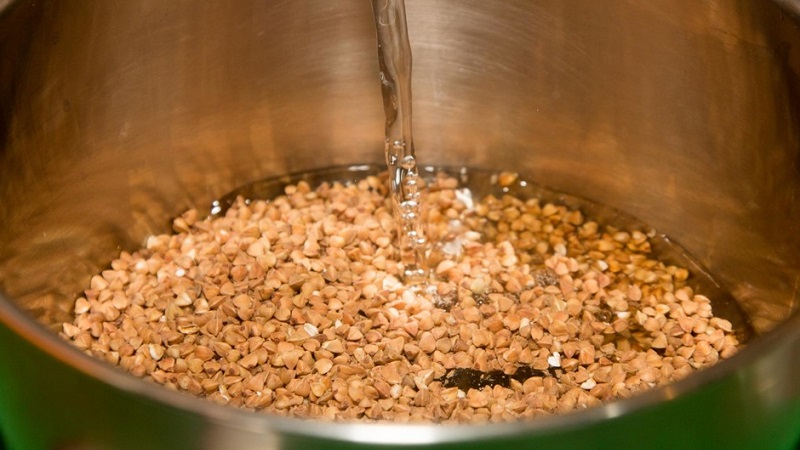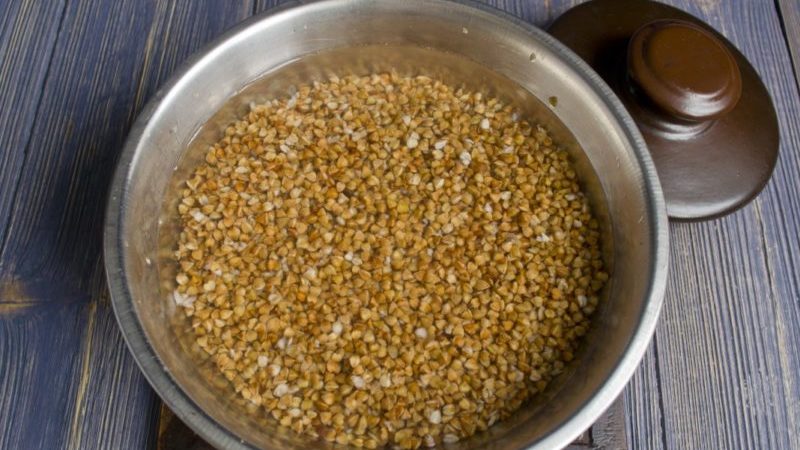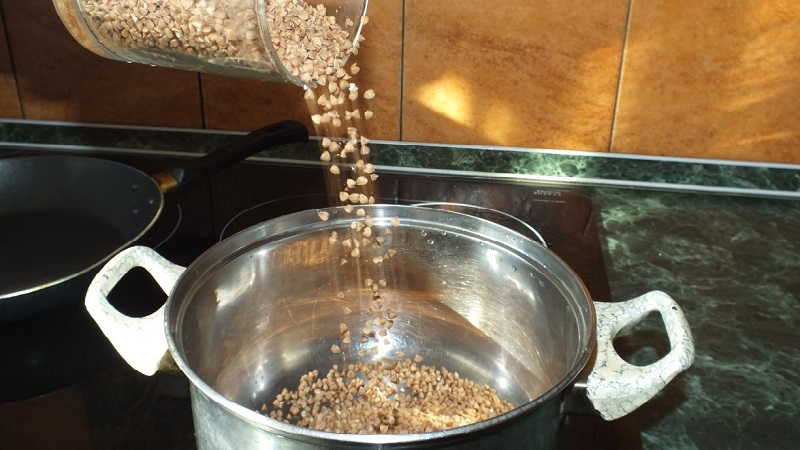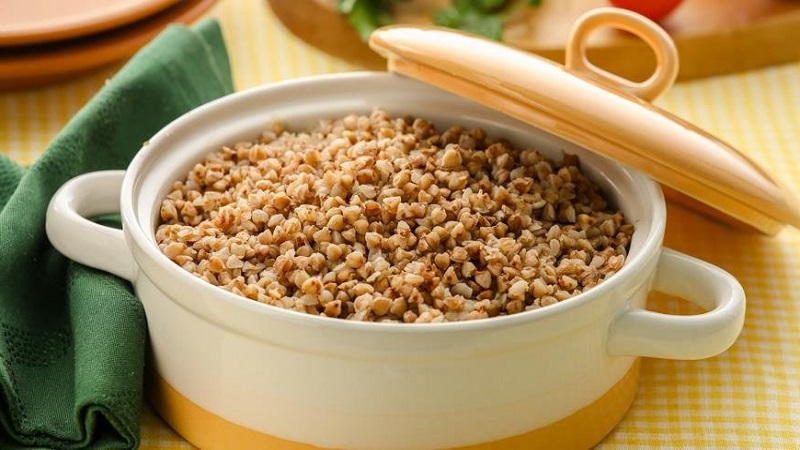How to properly rinse buckwheat and is it necessary to do it
Cereal dishes are part of the daily diet of many Russians. Buckwheat is especially popular in our country. But in the process of packing in factories, various debris often gets into the cereal, so it is advisable to rinse it before cooking. Read about how to do this correctly in our article.
The content of the article
Why rinse buckwheat

Buckwheat must be washed before cooking. This procedure is performed regardless of the cost of the product. Even in expensive cereals, poor-quality grains and various vegetable debris are often found.
Do I have to do it
You should not fully rely on the manufacturer's honesty, even if his product is of high quality and the label “clean” on the package. There is also garbage in expensive cereals.
Both the health of the gastrointestinal tract and the taste of the finished porridge, which is very different from the taste of unwashed cereals, depend on washing. Even in buckwheat, which is intended for baby food, there are various contaminants.
In cereals of the highest grade, the permissible amount of vegetable waste is 0.3%, second grade - 0.6%. To eliminate contamination, the cereals are thoroughly washed.
Where is the trash in it
What trash can be in the cereal:
- Fine grain particles that are not removed during production. They are not harmful in any way, but cooked buckwheat will not be crumbly.
- Grains in a black shell. This is a common cereal, but it did not respond well to processing. Such kernels spoil the taste of the finished product and injure the oral cavity.
- Sand, slag, earthy lumps, pebbles. All of this is potentially dangerous to the body. There is a possibility that a person injures a tooth while eating. Such garbage gets into the cereal during harvesting, but it is not completely removed in production.
- Vegetable debris. It includes particles of stems, husks and grains of other crops, which also fall into buckwheat during harvesting.
Crepe must be washed before cooking. If bought by weight, it is sorted by hand before cooking.
How to properly rinse buckwheat

To remove garbage from cereals, perform the following steps:
- Sort out the grains, removing foreign inclusions and unrefined kernels. The easiest way to do this is in a wide container, evenly distributing buckwheat along the bottom.
- Rinse thoroughly several times until the water is clear. During washing, the cereals are stirred by hand so that no impurities remain at the bottom.
It is not recommended to grind the kernels too much, as they will be damaged, due to which the finished porridge will stick together.
Before cooking
Before cooking, the sorted buckwheat is poured into a deep saucepan and placed under a strong stream of water for thorough rinsing. After that, the water is drained. The procedure is repeated 2-3 times. The main thing is that the water is ultimately clean.
If after 2-3 washes the water is still dirty, the procedure is repeated several more times. To make all the debris float up faster, the cereals are gently stirred. After that, they start cooking porridge.
Read also:
Before calcining
If, before cooking buckwheat, it is decided to ignite it, then preliminary rinsing is required.
Reference. Many manufacturers sell already washed and roasted cereals, which significantly saves time and effort during cooking.The washed buckwheat porridge has a slightly different color, and when ignited, it acquires a richer taste.
To make the washed cereal easy to ignite, it is poured onto a dry baking sheet in a small amount (layer up to 1 cm). Some housewives first ignite buckwheat, and then wash it, but only if it is not heavily contaminated.
Garbage is removed in the same way as in the previous method. First, the cereals are manually sorted, after which they are washed under running water several times.
Before frying
Roasting makes buckwheat more crumbly and less boiled. But in this case, the cereal loses some of the useful carbohydrates.
It is not necessary to wash the grains before frying, but most housewives still prefer to do this in order to remove unwanted impurities, such as sand and plant debris. Also, the procedure allows you to get rid of an unpleasant aftertaste. It is washed in a standard way that is used before cooking.
But during washing, the cereal absorbs moisture. When buckwheat is transferred to a frying pan, the process partially turns into cooking. This will cause the beans to be half cooked. Therefore, some housewives do not wash buckwheat before frying, but be sure to sort it by hand.
Before germination

Sprouted buckwheat is considered the most useful. Compared to rice, it has about 80 times more antioxidants.
Reference. Sprouted buckwheat is also called "live cereal". It is good for the nervous system and increases hemoglobin levels. Germinate cereals in a warm place during the day.
Flushing process:
- Green buckwheat is placed in a saucepan and covered with water. All floating particles are removed.
- After that, it is poured into some container of 2 cm layers and filled with purified water for 3 hours.
- Then it is poured into a sieve and washed with a strong pressure of running water.
After that, green buckwheat is transferred into a container intended for germination, covered with wet gauze and a lid. Leave a small gap for air to enter. If small sprouts appear on the grains, it means that buckwheat is ready for use. It is used as a side dish or as an ingredient in salads.
How to rinse buckwheat if there is no colander or sieve
Many housewives prefer to rinse without a colander. It is used only at the last stage, when all the debris has already floated in, in order to wash it more thoroughly.
Pour the groats into a saucepan and fill it with water, stir to speed up the process. When the pot is full, drain the water and repeat the process until the debris stops floating and the water is clear.
How to drain the water
The water is drained by gently tilting the pan. This will remove all floating particles as well. During repetitions of washing, the water is not completely drained.
At the last drain, the cereal is held by hand to remove the water as much as possible. If there is no strainer, use cheesecloth or press the lid against the pan and turn it over completely. The remaining water will seep through the gap.
Tips & Tricks

Basic tips and tricks for washing buckwheat:
- It is undesirable to rub the cereal strongly during washing. So it will absorb a lot of moisture and after cooking it will not be crumbly.
- Housewives do not recommend washing in hot water. The groats will swell, and the garbage will not float well.
- It is imperative to sort out buckwheat by hand, especially if it was bought by weight.
Read also:
How to eat buckwheat in case of poisoning and can it cause it
Calorie content and BZHU of boiled buckwheat with milk
Life hacks for Cinderellas: how to separate rice from buckwheat quickly
Conclusion
Before cooking, buckwheat must be thoroughly washed in order to remove garbage and improve taste. It is also important to pre-sort the groats to detect stones, especially if rinsing is not planned due to frying.